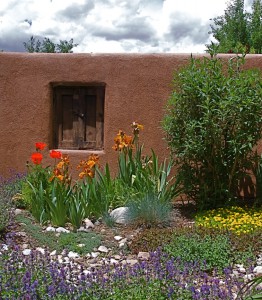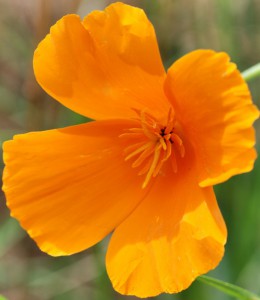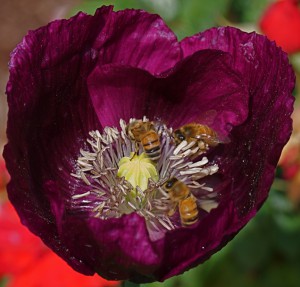Scientific Names include: Papaver somniferum, Papaver rhoeas, Eschscholzia californica, Argemone hispida
Family: Papaveraceae
By Susan Bruneini
Photos: Janice Tucker

Oriental poppies, Papaver orientale
Few flowers equal the poppy’s historical influence, including its legendary powers to sprout from the blood of fallen soldiers and create gold in the ground where it grows. The first known reference to the brilliant red flower named the “plant of joy” appeared in a Sumerian text dated circa 4,000 BC, and was associated with the gods of sleep. The poppy has generated wars, powerful trade ties and fascinating myths world-wide.
Poppies belong to a small family of flowering plants called the Papaveraceae, with about 250 species. Poppies are annual, biennial, or perennial herbs, woody shrubs or small trees. The leaves are alternate, lack stipules, and are often lobed or deeply dissected. The flowers are usually solitary, bisexual, and showy. The fruit is a many-seeded capsule that opens by a ring of pores or valves. When cut, stems or leaves ooze a milky, yellow, orange, or occasionally clear substance.
Papaver somniferum, or opium poppy, has been the source of opiates from early times (no other papaver includes opiate alkyloids). Poppy seeds and poppy oil have been used in cooking since the 2nd century BC. Today Holland and Canada are the main producers of poppy seeds for consumption.
Their vivid splash of color in cultivated gardens now includes every vibrant shade from brilliant reds, golden yellows, pinks, whites and dramatic magenta.
The poppy has been associated with mystical legendary powers. Fields that were barren before the Napoleonic wars in the early 1800s burst into bloom with the brilliant blood-red Papaver rhoeas after battles, but the plants disappeared quickly. Legends arose that the blood of fallen soldiers turned into the bright red poppies. During World War One, the same phenomenon was observed at Flanders Field. Historians now agree that lime excreted from battle debris provided excellent conditions for the poppies to thrive, but only for a brief period. The red poppy has become a symbol of peace, and for those fallen in war.

California poppy, Eschscholzia californica
Earlier (in the early 1800s) a Russian expedition docking in San Francisco Bay marveled at massive fields of golden California poppies and the myth arose that the poppies were the source of California gold, mysteriously creating the abundance of gold in the soil where they grew. The common name was Cup of Gold. Its botanical name, Eschscholzia californica, was assigned by Adelbert Von Chamisso, a naturalist and member of the Prussian Academy of Sciences.
The California poppy was widely used by Native Americans, both as a food source and for medicinal purposes. Some boiled or roasted the entire plant for consumption as a green. It was used as a sedative, or the root was made into a poultice for toothaches and topically applied for headaches and sores. The plant has sedative, analgesic and antispasmodic properties, but is far less powerful than the opium poppy. It became the California state flower in 1903, and April 6 is celebrated annually as California Poppy Day.
Leonora Curtin included a comment about the Argemone hispida (thistle poppy, prickly poppy, cardo santo), in her book, Healing Herbs of the Upper Rio Grande.
She stated,“at Cuyamungue, the entire plant is boiled in preparation for baths for rheumatism, dropsy and swellings, or dried roots are powdered and applied externally.” Today Argemone hispida grows along waysides, especially in southwestern New Mexico.

Breadseed poppy 'Lauren Springer Grape' P. somniferum
Today, poppies add vivid color to gardens. One of the most spectacular varieties is the Lauren Springer Breadseed poppy. Springer was obsessed with growing every type of poppy, and would even scrape seeds off of bagels to see what might happen if they sprouted. After years of experimenting, she produced a magnificent magenta poppy. For six years she pulled all other poppies in her garden that did not display the true color she was seeking. The result was the Lauren Springer poppy (see image).
According to Malcolm Newman, owner of Newman’s Nursery, poppies do very well in Santa Fe’s climate and alkaline soil. “They are spring and early summer bloomers and tolerant of cooler weather,” he said. “Georgia O’Keefe’s well-known poppy image symbolizes the relationship between poppies and Northern New Mexico. Other poppies that grow well in Santa Fe are Oriental, California, Lauren Springer and many others available in the spring from local growers,” he added.


